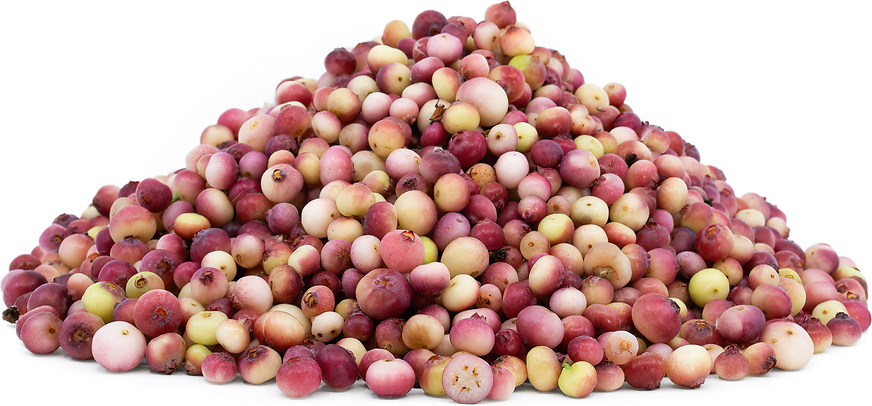


Pink Lemonade Blueberries
Estimated Inventory, bskt : 3.00
This item was last sold on : 08/02/25
Description/Taste
Pink Lemonade blueberries are a fuschia-colored variety of blueberry. They tend to be slightly smaller than most blueberries and start off a yellow-green hue, then ripen into a glossy dark pink tone. Their skin is smooth and almost translucent, similar to that of a red grape. They are firm and have a slightly dusty texture. Pink Lemonade blueberries' flesh is light pink and translucent, with a juicy texture that easily emits liquid and contains small seeds. Pink Lemonade blueberries have a sweet, fruity aroma. Their taste is likewise sweet with flowery notes and a slightly tart and citrusy undertone that distinguishes it from blue-colored varieties.
Seasons/Availability
Pink Lemonade blueberries are available during the mid-summer months.
Current Facts
Pink Lemonade blueberries are known botanically as Vaccinium 'Pink Lemonade' and are from the Ericaceae family. They are a rabbiteye variety of blueberry, characterized by a blush-pink color resembling the eyes of a white rabbit, rather than the traditional purple-blue tone of other blueberries. This pink hue gives off the illusion that they are unripe when really they are much sweeter than other varieties. Pink Lemonade blueberries are often used as an ornamental plant because they produce white and pink bell-shaped flowers during the spring and yellow, orange, and burgundy flowers during the fall. These shrubs are often used to create hedges in landscaping. Because of their compact size, Pink Lemonade blueberries can be grown in small gardens or planted in containers—more convenient for those with less gardening space.
Nutritional Value
Though little is known about the nutritional value of the Pink Lemonade species, blueberries in general are known for being high in antioxidants. Among these antioxidants include vitamin C, vitamin E, anthocyanins, and flavonoids. These nutrients may help with immune support, skin and heart health, cell protection, inflammation reduction, cognitive function, blood sugar control, and preventing the growth of cancer cells. Blueberries also contain vitamin K1 and manganese, which help encourage blood clotting, bone health, and protein and carbohydrate metabolism. Blueberries are a source of fiber, which helps with digestion and may have protective effects against cardiovascular diseases, type 2 diabetes, constipation, and hemorrhoids.
Applications
Pink Lemonade blueberries can be consumed fresh or baked. In their raw form, they can be eaten fresh out of hand or used in fruit salads, cocktails, trail mix, yogurt parfaits, granola, or as a garnish for desserts like cheesecake or pastries. Pink Lemonade blueberries can be baked into tarts, pies, cakes, and muffins or frozen to make ice cream or sorbet. They can be preserved with sugar to make jam, jelly, or compote. Pink Lemonade blueberries can be used to make a sauce or syrup for pancakes, waffles, or baked goods. They pair well with other fruits like watermelon, blackberries, strawberries, raspberries, cherries, peaches, apricots, passionfruit, apples, bananas, and oranges. Pink Lemonade blueberries are complemented by the flavors of sweet cherry tomatoes, beets, butternut squash, avocados, almonds, cilantro, lemongrass, coffee, chocolate, toasted bread, shrimp, and crab. When harvesting, it’s best to pick them off the bush in the morning before they’re exposed to the heat. Because they bruise easily, these blueberries should be refrigerated as soon as they’re picked to keep them fresh for up to two weeks.
Ethnic/Cultural Info
Pink Lemonade blueberries are a hybrid breed created by plant geneticist Mark E. Ehlenfeldt. One of its parents is a breed created by a scientist from Rutgers University named Nicholi Vorsa. The other parent was a commercial blueberry developed by the USDA and the University of Georgia called the Delite. Ehlenfeldt started this breeding process in 1991 and by 1996 an offspring of the two parents was chosen and tested on both the East and West Coast. After experiencing growing popularity at a nursery near Corvallis, Oregon, it was released commercially in 2005 and given the name “Pink Lemonade” blueberries in 2007, the same year it won the title of best new shrub at the Far West Horticultural Show in Portland, Oregon.
Geography/History
Pink Lemonade blueberries were invented in the United States and continue to grow in most areas of the country. They can grow in places that experience both cold and warm weather, though they need plentiful sunshine to grow and won’t flourish if temperatures dip below 0°F, which is why this plant grows mostly in the summer. As a hybrid breed, Pink Lemonade blueberries do not grow in the wild and are instead cultivated in home gardens or produced commercially. This variety grew in popularity after having been released commercially in 2005, attracting consumers and fruit enthusiasts with its sweet flavor and unique color. Despite this appeal, Pink Lemonade blueberries remain relatively rare and are more likely to be sold as seeds than as a fruit. They may occasionally be found at specialty stores and farmers’ markets in the United States.
Featured Restaurants
Restaurants currently purchasing this product as an ingredient for their menu.
| Herb & Wood | San Diego CA | 520-205-1288 |
| Leu Leu | Leucadia CA | 619-316-5807 |
| The Guild Hotel | San Diego CA | 619-764-5108 |
| Paradisaea Dodo Bird | La Jolla CA | 732-915-6669 |
| Lauberge Del Mar | Del Mar CA | 858-259-1515 |
| Mabel's Gone Fishing | San Diego CA | 619-228-9851 |
| La Costa Resort & Spa Main Kitchen | Carlsbad CA | 760-930-7063 |

















